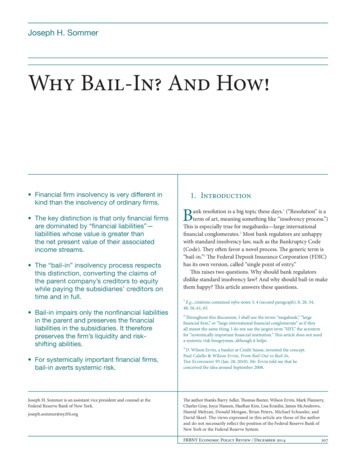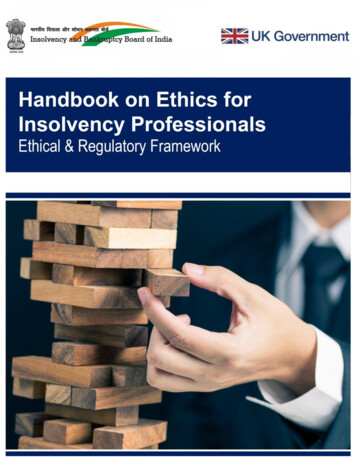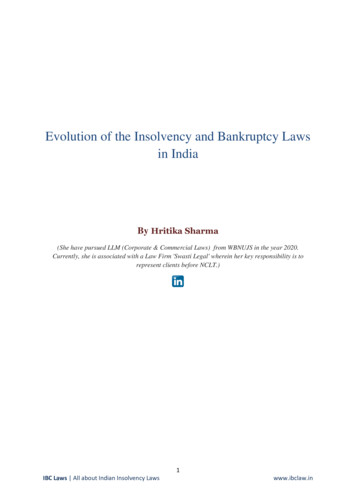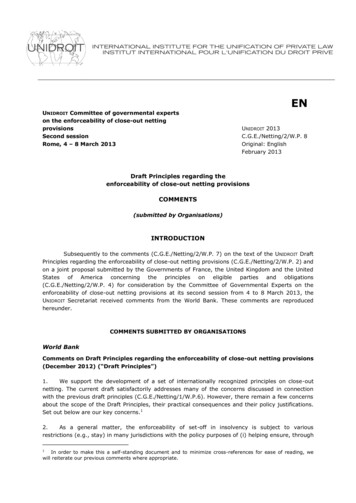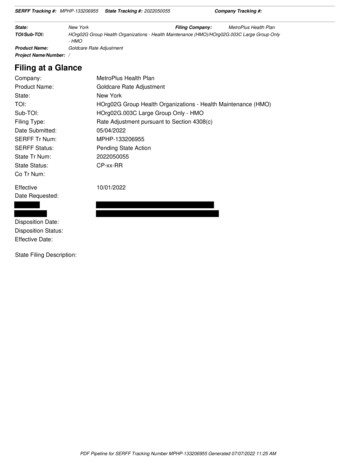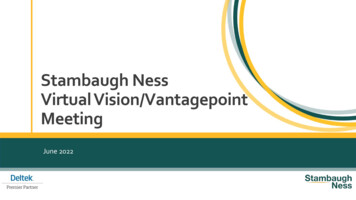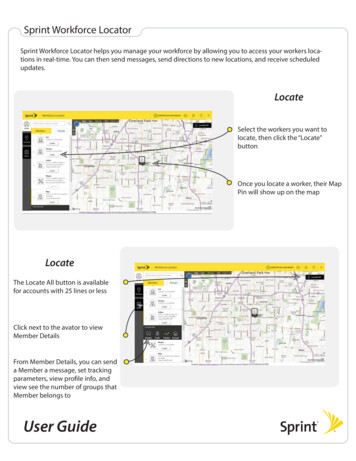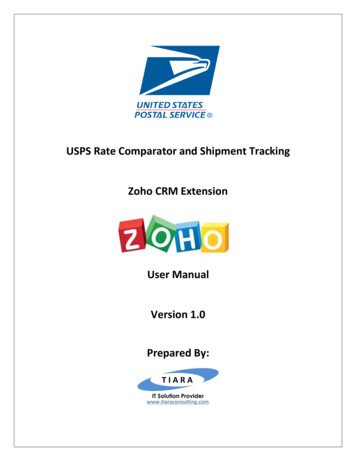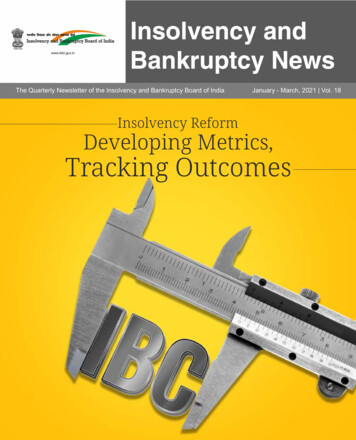
Transcription
The Quarterly Newsletter of the Insolvency and Bankruptcy Board of IndiaJanuary - March, 2021 Vol. 18Insolvency ReformDeveloping Metrics,Tracking Outcomes
C O N T E N T SFrom Chairperson's Desk 2IBBI Updates 4Legal and Regulatory Framework 5Ÿ Central GovernmentŸ Insolvency and Bankruptcy Board of IndiaŸ Other AuthoritiesOrders 6 Supreme Court High Courts National Company Law Appellate Tribunal National Company Law Tribunal Special Courts Central Information Commission Insolvency and Bankruptcy Board of IndiaCorporate Processes 12Ÿ Insolvency ResolutionŸ LiquidationŸ Voluntary LiquidationIndividual Processes 19Service Providers 20Ÿ Insolvency ProfessionalsŸ Information UtilityŸ Registered ValuersŸ Complaints and GrievancesExaminations 23Ÿ Limited Insolvency ExaminationŸ Valuation ExaminationsBuilding Ecosystem 23Advocacy and Awareness 26“The Code was an imperative need for the nation to try and catch up with the rest of the world, be it in the matter of ease of doing business, elevating therate of recovery of loans, maximization of the assets of ailing concerns and also, the balancing the interests of all stakeholders.”Supreme Court in the judgement dated January 19, 2021 in the matter of Manish Kumar Vs. Union of India & Anr (WP No. 26/2020)“The Code has brought about signi cant behavioural changes among the creditors and debtors thereby rede ning debtor-creditor relationship. Theinevitable consequence of a resolution process (the control and management of the rm move away from existing promoters and managers, mostprobably, forever) deters the management and promoter of the rm from operating below the optimum level of ef ciency. Further, it encourages thedebtors to settle default expeditiously with the creditor at the earliest, preferably outside the Code.”Chapter 4, Economic Survey 2020-21“To ensure faster resolution of cases, NCLT framework will be strengthened, e-Courts system shall be implemented and alternate methods of debtresolution and special framework for MSMEs shall be introduced.”Hon’ble Minister of Finance and Corporate Affairs, Smt. Nirmala Sitharaman, Budget Speech on February 1, 2021
From Chairperson’s DeskInsolvency Reform: Developing Metrics, Tracking OutcomesThe question that I have been asked the most is: “How do you assessoutcomes of the Insolvency and Bankruptcy Code, 2016 (Code)?” Thequestioner often does not expect a professional response, but a validationof his own assessment. He has assessed the outcome based on his ownperception of a transaction value, a process ow, a design feature, animplementation issue, a deviation from expectation, a comparison with theerstwhile regimes, etc. depending on his exposure, caliber, interests, andideological inclination.Every economic reform, including insolvency reform, does somewhatrecast the rules of the game for market participants with a view to increaseoverall economic wellbeing. As such, it may affect interests of participantsdifferently: some may stand to gain while others may lose, as compared tothe old order. It is unlikely that a loser or a gainer, who is generally blindedby his self-interest, will use a metric that holistically and objectively assessesoutcome of the reform. He tends to cite purposive examples to buttresseshis perspective. A bene ciary of the old order, for example, may cite thelikes of Ghotaringa Mineral Limited and Orchid Healthcare Private Limitedto cry foul of the insolvency reform. He may claim that insolvencyproceedings of these two companies under the Code realised preciouslittle for creditors as against their claims of a few thousand crore rupees. Hemay not, however, posit that these companies had absolutely no assetswhen they entered the insolvency proceedings. Thus, the choice of metricdepends on which side of the table the participant sits.A dispassionate analyst, who looks at the reform from a macro perspective,is likely to use a metric that is readily available, easily understood, andamenable to analysis, rather than what is the most appropriate. Authentic gures about recovery through insolvency proceedings are readilyavailable. Recovery, both in absolute and relative sense, is easilyunderstood. It can be used to compare resolution of one company withthat of another, or to compare different options for resolution andrecovery. Some analysts may prefer to use recovery as a metric to assessthe outcome as a matter of convenience, even though it is not an objectiveof insolvency reform, and it arises only as a by-product of the insolvencyproceedings. Time taken for closure of an insolvency proceedings isanother convenient metric. An optimist analyst may observe time takenunder the Code as compared to that under erstwhile regimes, while apassionate critic may focus on the gap between time taken and the timeenvisaged under the Code.Some of the convenience metrics could be misleading. Recovery, though aprecise metric, is not unambiguous. The resolution plans under the Coderecover, on an average, about X% of admitted claims of creditors. Suchlevel of recovery could be good for someone as, of the available options, itrecovers the best. This may not be so good for another, as it entails ahaircut of Y% for creditors. Further, recovery as a percentage of admittedclaim, which most often is not in sync with the reality, may not make muchsense. What could be realised is re ected by liquidation value of the assetsavailable in the books of the debtor. What should be realised is re ected bythe written down value of the debt in the books of the creditor. Recoveryas compared to what should or could be realised presents a picture entirelydifferent from X% or Y%.A student of law and economics looks at insolvency reform from a muchdeeper perspective. He believes that every economic actor has boundedrationality and cannot anticipate all possible contingencies. It enters intocontracts, and renegotiates and modi es its terms, as and whencircumstances change, and yet every contract at any point of time remainsan incomplete one, with gaps and missing provisions. Nobel laureate inEconomic Sciences, Mr. Oliver D. Hart argues that a rm enters into aseries of incomplete contracts which allow every creditor foreclosurerights over rm's assets in lieu of credit. Every creditor feels comfortable onstandalone basis and the rm meets commitment towards each creditor innormal course and the life goes on. However, when the rm is stressed, itcan honour claims of one or a few creditors fully, but not all creditorssimultaneously. It is a situation where claim of an individual creditor isconsistent, but claims of all creditors together is inconsistent, with theassets of the rm. If every creditor sticks to its pre-insolvency rights,neither resolution of stress is possible nor can a creditor realise its dues.The insolvency framework endeavours to resolve such a stress whiledischarging obligations towards creditors to the extent realistically possibleunder the circumstances. Insolvency reform is thus an overarchingcontract, that completes all incomplete bilateral and multilateral contracts,makes claims of all creditors consistent and prevents a value reducing runon the assets of the rm and thereby tries to rescue the debtor andcreditors. But for the overarching contract, the parties would enforce aseries of incomplete contracts, which may wipe out the debtor and writeoff some creditors. A student of economics may nd a metric in the lives ofthe debtors rescued, the loss avoided to creditors and improved capacityutilisation. Where contract enforcement takes years as compared to timebound closure of insolvency proceedings, the time saved in contractenforcement may serve as the metric for a student of law. Given thatcontract enforcement is fundamental to markets, a policy maker mayconsider improvement in ease of doing business and consequentlyeconomic development as the metric.Economies compete to make the environment easier for doing business. Itis easier to do business in an economy, which provides, protects andenforces economic freedom at marketplace. Freedom is paramount for abusinessman. He needs freedom to start a business whenever he nds anopportunity, freedom to compete at marketplace, and freedom to exitwhen the business fails. He typically commences a business when he hasthe reassurance of exit in case of failure. He may fail when he becomes avictim of Schumpeter's “gale of creative destruction”, where his business isfailing to earn normal pro ts, either because it is outdated or the space isovercrowded. Higher the intensity of competition and innovation in aneconomy, higher is the rate of failure, higher is the incidence of sunrisebusinesses replacing the sunset ones, and higher is the need for freedom toexit. An honest businessman uses the degree and quality of freedom to exitfrom business as the metric to assess the outcome of insolvency reform.We are familiar with the parable of the blind men and an elephant, whereeach of the seven blind men describes an elephant based on his own limitedexperience. Like the description of an elephant by one person, a singlemetric may fail to adequately capture the outcome of insolvency reform.The World Bank Doing Business Report uses a composite metric, whichstudies the time, cost and recovery of insolvency proceedings and strengthof the insolvency framework to arrive at a score for resolving insolvency foran economy. It has its limitations given that the methodology has beendrawn up to cater to about 200 countries, each of which has had a uniqueexperience in the insolvency outcomes.A single metric or a composite metric often does not capture softer aspectssuch as humanitarian approach while dealing with insolvency, or invisibleoutcomes in terms of behavioural changes of stakeholders. They generallydo not capture the systemic gains such as induced resolutions outside theCode, liberation of entrepreneurs from failure, rescue of companies indeep distress, release of idle resources for productive uses, andmeritocratic lending and improved availability of credit. It is because ametric tends to capture what can be measured and it ignores the mattersthat cannot be measured even if they matter. As Elliot Eisner puts: “Noteverything that matters can be measured, and not everything can bemeasured matters.”A well laid metric, instead of or in addition to measuring outcomes, mayin uence the outcome. In other words, when we set one parameter as ameasure of outcome, there is a tendency to achieve the same, and evengame the same, overlooking other equally, or even more important aspectsand dimensions of the outcomes. Goodhart's Law cautions: “When ameasure becomes a target, it ceases to be a good measure.”A metric is not a onetime affair. After it is conceptualised and itsmethodology nalised, it needs to be nurtured for years with appropriatemodi cations with changing times and evolving practices. Systems need tobe in place to generate the metric with suitable frequency. Provisions need2
INSOLVENCY AND BANKRUPTCY NEWSto be made for feeding authentic data and information for servicing themetric. In different spheres, specialised organisations have come up tomaintain and service different metrics. It is the time to sow the seeds of asound metric(s) for tracking the outcomes of insolvency reform when it istaking deeper roots in the country. The metric(s) should holistically andobjectively measure the outcome, involving evaluation of the structure,processes and designs of the market contributing to the fairness, integrityand credibility of the market in each of the segments, namely, corporateinsolvency and liquidation, and individual insolvency and bankruptcy. If noguidance is available as to what is an appropriate metric, and there is noprovision of data / information to service such a metric, the market may useany convenience metrics, which may do more harm than good to the causeof insolvency reform.While encouraging debate on development of metrics, the scholars mayexplore metrics to measure outcomes of the Code around its sixfoundational objectives. These are: (a) resolution of stress;(b) maximisation of value of assets; (c) promoting entrepreneurship;(d) enhancing availability of credit; (e) balancing of interests of allstakeholders; and (f) establishing an ecosystem. These objectives can betranslated into six possible layers of outcomes of an insolvency andbankruptcy regime:(a) The growth, strength and ef ciency of the insolvency ecosystemconsisting of insolvency professionals, insolvency professional agencies,insolvency professional entities, registered valuers, registered valuerorganisations, information utilities, Adjudicating Authority, AppellateTribunal, IBBI, Government, Courts, etc.;(b) The strength, ef ciency, and ef cacy of the processes, namely,corporate insolvency resolution, corporate liquidation, voluntaryliquidation, pre-packaged insolvency resolution, fresh start process,resolution of personal guarantors to corporate debtors, resolution ofproprietorship and partnership rms, individual insolvency resolution,bankruptcy, etc.;( c) The growth and ef ciency of markets such as markets for interim nance, resolution plans, liquidation assets, insolvency services, along withcost ef ciency, information ef ciency, etc.;(d) The impact on businesses in terms of cost of capital, capital structure,availability of credit, entrepreneurship, capacity utilisation, creativedestruction, competition innovation, etc.;(e) Behavioural changes amongst the debtors and creditors, trust of thecreditors in debtors, meritocratic lending, non-observable impact,humanitarian considerations, proactive/ preventive impact of the Code,etc. and(f) The overall impact on employment, income and economic growth ofthe nation.Table below lists these layers of outcomes and possible indicators for tracking them.IndicatorLayer of OutcomeObjectiveStrength of insolvency ecosystem To aid the processes in pursuit of objectives of the Code-Strength of each of the elements of the ecosystem.Performance of each of these elements.Strength of insolvency processesTo aid stakeholders to pursue the objectives of the Code-Use of the processes under the Code by creditors and debtors ascompared to other available options.Ef ciency of the processes in terms of cost-time-recoveryframework.Strength of insolvency marketsTo aid the insolvency processes to arrive at competitive market outcomes-Availability of interim nance.Availability of competitive resolution plans.Cost and information ef ciency of the markets.Impact on businessesEnhance availability of credit, promote entrepreneurship, drive competition and innovation-Impact on cost of capital.Change in capital structure of rms.Impact on availability of credit.Entrepreneurship culture in the economy.Behavioural changesDesired behaviour through incentives and disincentives-Proactive / preventive resolutions.Resolutions in the shadow of or on account of the Code.Settlements during resolution process.Meritocratic / cleaner lending.Overall impactImprovement in corporate governance, resource allocation, and economic growth -Employment saved because of resolution of distressed companies.Amount of recoveries by creditors being ploughed back into thecredit cycle.Capacity utilisation and resource allocation.Impact on economic growth of the country.Usually, the data necessary to build metrics for assessing the outcomes ofan insolvency regime are scattered and challenging given the dynamics ofthe market. Given that India's insolvency regime is still nascent andunique, data systems in respect of insolvency are just emerging. Theimportance of having an ex-ante strategy for ex-post evaluation highlightsthe data requirements of the evaluation and, by doing so, allows earlycollection of the necessary information. The time is ripe to harness thedata being generated under the Code and decipher measurable impactsof the Code. It is imperative to have a clearly de ned framework ofindicators to monitor and measure outcomes of the Code that aretracked and reported on a regular basis against the objectives/benchmarks. It should be strengthened with an institutional arrangementto steer generation and dissemination of relevant data and encourageuseful research in matters of policy design and implementation. It will3facilitate informed public debate on policies and thereby help incrowdsourcing of ideas for good policy response. Data driven analysis willnot only enrich the policymaker's toolkit for sound policy making, thathave a direct bearing on the bene ciaries or stakeholders of the Code butwill also be useful for other purposes like supervision of banks and nancial institutions, monitoring of nancial systems, or generalmacroeconomic models.Developing metrics and tracking the outcome of a complex policyinstitutional change is not an easy task, unlike in the case of projects orprogrammes. It is necessary to develop a dynamic multivariate metric,which uses both quantitative and qualitative tools, to capture theoutcomes of a poly-centric insolvency reform.(Dr. M. S. Sahoo)
INSOLVENCY AND BANKRUPTCY NEWSIBBI UpdatesParliamentary Standing CommitteeThe Parliamentary Standing Committee on Finance took oral evidence ofthe representatives of the Ministry of Corporate Affairs (MCA) on thesubject “Implementation of Insolvency and Bankruptcy Code-Pitfalls andSolutions” on January 12, 2021. Secretary and other of cers of the MCAand Chairperson, IBBI appeared before the Committee.Employee Trainings and WorkshopIBBI organised the following workshops and trainings for its of cersthrough e-mode:Date23-01-2108-02-2109-02-21Nature of Programme/SubjectThe Right to Information Act, 2005Bankruptcy Law - The Role ofCredit ChannelsInsolvency Law and its impact03-03-21Debt Relief Order Model of UKFacultyMr. Vadali Rambabu, Deputy Secretary, ISTMDr. (Ms.) Udichibarna Bose, Assistant Professor inFinance, Essex Business School, University of EssexDr. (Ms.) Aparna Ravi, Partner, Samvad Partnerson SocietyMs. Samantha Ware and Ms. Sam RobertsCOVID-19During the ongoing COVID-19 pandemic, the functioning of the of ces ofIBBI were regulated in keeping with various instructions from theGovernment in terms of ensuring hygiene at workplace and strength ofstaff present in of ce. The of cers/staff attending of ce continued to followprotocols such as wearing of masks, ensuring social distancing andmaintaining hand hygiene. In keeping with the orders of the Government,all of cers and staff were required to attend of ce regularly with effectfrom February 15, 2021. Staggered of ce hours were put in place to avoidovercrowding in the of ces. Standard Operating Procedure on preventivemeasures to contain the spread of COVID-19 in of ces, as issued by theMinistry of Health and Family Welfare is being strictly adhered to. Apartfrom these initiatives, periodic RTPCR tests were conducted for staff aspreventive measures.International Women’s Day CelebrationTo mark the occasion of International Women's Day, the IBBI organised aSeminar on March 8, 2021, on the lines of this year’s United Nations’theme “Women in Leadership: Achieving an equal; future in a COVID-19world”. Ms. Sumitra Mahajan, former Speaker, Lok Sabha was the ChiefGuest at the occasion. She highlighted that women are making a mark inevery eld, including the budding profession of Insolvency Professionals.Their role during the pandemic has been extra-ordinary.The other dignitaries who spoke on the occasion were Ms. Sudha R.Relangi, Director (Prosecution), Central Bureau of Investigation; Ms.Madhavi Divan, Additional Solicitor General; and Ms. Tripti Singhal Somani,Founder, Wommenovator & Co-chairperson, MSME Committee,PHDCCI. The technical session on “Insolvency Professionals and Women:Multi Taskers” was moderated by Ms. Jyoti Vij, Dy. Secretary General,FICCI. The Seminar also had an experience sharing session on “SuccessfulResolutions under the Code”, moderated by Ms. Jyoti Jindgar, Advisor,Competition Commission of India. The seminar was live streamed.Session on Bankruptcy Law - The Role of Credit Channels, February 8, 2021Session on Insolvency Law and its impact on Society, February 9, 2021International Women’s Day celebration, March 8, 2021Human ResourcesExecutive DirectorMr. K. R. Saji Kumar, Executive Director, was repatriated to his parentcadre, Legislative Department, Ministry of Law & Justice, on their request,on January 11, 2021.Session on Debt Relief Order Model of UK, March 3, 20214
INSOLVENCY AND BANKRUPTCY NEWSThe of cers/Members of IBBI attended the following workshops andtraining programmes.Date06-01-21 to 10-02-2104-01-21 to 22-01-2111-01-2106-02-2108-02-21 to 10-02-21Organised byIICAFOIRNPCFOIRFOIRNature of the Programme/SubjectNo. of Of cersCommercial Mediation & Negotiation01Emerging Regulatory Issues in Digital Era02Good Governance & Transparency through RTI01Regulatory Governance02Capacity Building Program02Legal and RegulatoryFrameworkCentral GovernmentSuspension of initiation of CIRPThe Government had, through an amendment to the Code on June 5, 2020,suspended ling of applications for initiation of CIRP under sections 7, 9 and 10,in respect of any default arising during the period of six months commencing onMarch 25, 2020. This suspension was later extended twice by further periods ofthree months each. Accordingly, the suspension expired on March 24, 2021.Pre-packaged resolutionThe sub-committee of the Insolvency Law Committee (ILC) had submitted itsReport on Pre-packaged Insolvency Resolution Process (PPIRP) on October 31,2020 along with a pre-pack framework within the basic structure of the Codefor the Indian market. The MCA, vide noti cation dated January 8, 2021, invitedcomments/suggestions from public on this PPIRP framework.Tenure of members of NCLATThe Central Government, vide noti cation dated January 5, 2021, extended theterm of Justice (Retd.) Mr. Bansi Lal Bhat and Justice (Retd.) Mr. A.I.S. Cheema asJudicial Members of the National Company Law Appellant Tribunal (NCLAT) tilltheir attaining the age of 67 years, or until further orders, whichever is earlier.Chennai Bench of NCLATThe NCLAT, vide noti cation dated January 23, 2021, noti ed that its ChennaiBench would start functioning from January 25, 2021 through virtual mode.Therefore, fresh appeals against the orders of the Benches of the NationalCompany Law Tribunal (NCLT) having jurisdiction of Karnataka, Tamil Nadu,Kerala, Andhra Pradesh, Telangana, Lakshadweep and Puducherry shall bemade before the Chennai Bench. Further, the ling of InterlocutoryApplications / Reply / Rejoinder, etc. in respect of these appeals will also bemade before the Chennai Bench as per the NCLAT Rules, 2016 and thestandard operating procedure.Physical hearing by NCLTThe NCLT, vide an order dated February 23, 2021, directed all NCLT benchesto start regular physical hearing with effect from March 1, 2021. However, onrequest of any counsel/representative of parties expressing dif culty in physicalhearing, a virtual hearing may be permitted. Further, a few of the Benches(Jaipur, Chandigarh, Guwahati, Cuttack, Kochi and Hyderabad) shall remainattending the matters through video conference.Mining RulesMinistry of Mines, vide noti cation dated March 24, 2021, noti ed the Minerals(Other than Atomic and Hydro Carbons Energy Minerals) Concession(Amendment) Rules, 2021. The amended Rules specify the manner of transferof letter of intent to the transferee consequent to the conclusion of insolvency,liquidation, or bankruptcy proceedings, as the case may be, of the originalholder of the letter of intent (transferor) by the competent Tribunal or theCourt under the provisions of the Code.IBBIAmendments to Model Bye-Laws RegulationsIBBI amended the IBBI (Model Bye-Laws and Governing Board of InsolvencyProfessional Agencies) Regulations, 2016, vide noti cation dated January 14,2021, enabling the Governing Board of an IPA to specify the eligibility norms foran individual to be a shareholder director. It provides for self-evaluation of theGoverning Board every year within three months of the closure of the year. Itrequires that an IPA shall designate or appoint a compliance of cer, who shall beresponsible for ensuring compliance with the provisions of the Code andregulations, circulars, guidelines, and directions issued thereunder. He shall,immediately and independently, report to the Board any non-compliance of theprovisions.5Amendments to CIRP RegulationsIBBI amended the IBBI (Insolvency Resolution Process for Corporate Persons)Regulations, 2016, vide noti cation dated March 15, 2021 to provide for thefollowing:(a) A creditor shall update its claim as and when the claim is satis ed, partly orfully, from any source in any manner, after the insolvency commencement date.(b) The IRP/RP shall le Form CIRP 7 within three days of the due date, whereany of the following activities is not completed: Public announcement is not made by T 3rd day; Appointment of RP is not made by T 30th day; Information memorandum (IM) is not issued within 51 days from the dateof public announcement; Request for resolution plan is not issued within 51 days from the date ofissue of IM; CIRP is not completed by T 180 days.Amendments to Liquidation Process RegulationsIBBI amended the IBBI (Liquidation Process) Regulations, 2016, videnoti cation dated March 4, 2021, requiring the Liquidator to le the list ofstakeholders, as modi ed from time to time, on the website of the Board. Itdiscontinued the requirement of announcement of ling of list of stakeholderswith the Adjudicating Authority in the newspapers.CircularsRetention of records relating to CIRPThe Code read with Regulations require an IP to maintain several records inrelation to the assignments conducted by him. Regulation 39A of the CIRPRegulations mandates the IRP and the RP to preserve a physical as well as anelectronic copy of the records relating to the CIRP, as per the record retentionschedule as communicated by the Board in consultation with IPAs. Keeping thisin view, in consultation with the IPAs, IBBI issued a circular on January 6, 2021directing the IPs to preserve an electronic copy of all the records for a minimumperiod of eight years and a physical copy of all records for a minimum period ofthree years. An IP shall preserve records relating to that period of a CIRP whenhe acted as IRP or RP, even though he did not take up the assignment from itscommencement or continued the assignment till its conclusion. He shallpreserve the records at a secure place and ensure that unauthorised persons donot have access to the same. Notwithstanding the place and manner of storage,the IP shall be obliged to produce records as may be required under the Codeand the Regulations.Applications for insolvency resolution process for PGs to CDsRule 9 of the Insolvency and Bankruptcy (Application to Adjudicating Authorityfor Insolvency Resolution Process for Personal Guarantors to CorporateDebtors) Rules, 2019 requires the applicant to provide a copy of the applicationfor initiation of insolvency resolution process of a personal guarantor (PG) to aCD, inter alia, to Board for its records. For the convenience of applicants, IBBImade available a facility on its website for providing a copy of the applicationonline to the Board. A circular to this effect was issued on February 2, 2021.List of stakeholders under Liquidation Process RegulationsThe IBBI (Liquidation Process) Regulations, 2016 require the Liquidator to lethe list of stakeholders on the electronic platform of the Board fordissemination on its website. For convenience, IBBI, vide circular dated March4, 2021, made available a facility on its website for ling of list of stakeholders aswell as updating it. The platform permits multiple lings by the Liquidator as andwhen the list of stakeholders is updated by him. The circular directs the IPs to le the list of stakeholders of the respective CD under liquidation andmodi cation thereof, in the prescribed format, within three days of thepreparation of the list or modi cation thereof.GuidelinesAdministrators GuidelinesIBBI issued the Guidelines for Appointment of IPs as Administrators under theSecurities and Exchange Board of India (Appointment of Administrator andProcedure for Refunding to the Investors) Regulations, 2018, prepared inconsultation with Securities and Exchange Board of India (SEBI) on March 9,2021 to govern the preparation of a Panel of IPs for appointment asAdministrators. These Guidelines are applicable for appointments ofAdministrators with effect from April 1, 2021.Online Delivery of Educational CoursesIBBI, extended the IBBI (Online Delivery of Educational Course and Continuing
INSOLVENCY AND BANKRUPTCY NEWSProfessional Education by Insolvency Professional Agencies and RegisteredValuer Organisations) Guidelines, 2020 till September 30, 2021 vide noti cationdated March 11, 2021, in view of the pandemic situation.Other AuthoritiesSEBI: Listing and Disclosure ObligationsSEBI, vide its noti cation dated January 8, 2021, amended the SEBI (ListingObligations and Di
studies the time, cost and recovery of insolvency proceedings and strength of the insolvency framework to arrive at a score for resolving insolvency for an economy. It has its limitations given that the methodology has been drawn up to cater to about 200 countries, each of which has had a unique experience in the insolvency outcomes.
